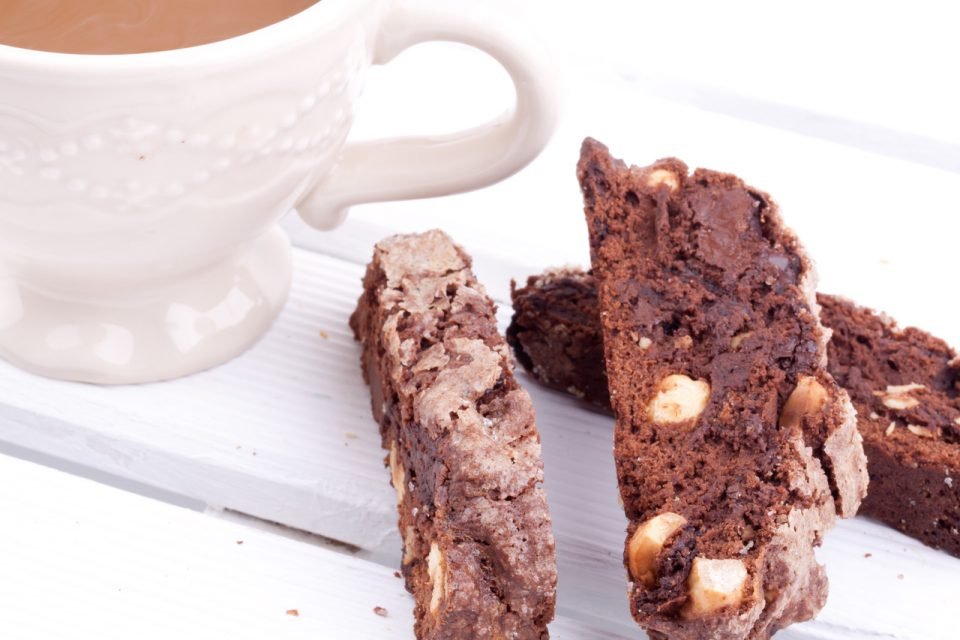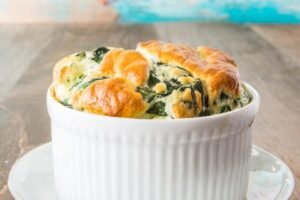
These biscotti are definitely not the traditional cookies your Italian grandmother might have made, but they’re absolutely delicious and quite straightforward to prepare once you have all the ingredients, even though the process involves multiple steps. Anyone who has tried them can attest to their delightful flavor; they might just be the best cookies you’ll ever taste. You can prepare the candied zest, toasted coconut, and toasted almonds in advance—whether that’s days, weeks, or even months before—and keep them frozen or in the refrigerator.
Ingredients:
– 4 cups (18 ounces) all-purpose flour
– 1 teaspoon baking powder
– 1 teaspoon kosher salt
– ¾–1 cup Dutch-process cocoa powder
– 8 ounces unsalted butter, softened
– 1 cup light brown sugar, packed
– 1 cup granulated sugar
– 4 jumbo eggs, plus egg white from 1 additional egg for the egg wash
– ¼ cup orange simple syrup, plus a little extra for the egg wash (This syrup can be made when preparing the candied orange zest and lasts indefinitely if stored in a Ball jar in the refrigerator.)
– 2 teaspoons pure almond extract
– 1 teaspoon pure coconut extract (omit if it’s synthetic, as it may add an unpleasant flavor)
– 1 teaspoon lemon oil
– 1 teaspoon orange oil (available from King Arthur Flour)
– 1 teaspoon pure orange extract
– 1 tablespoon pure vanilla extract
– 1 cup candied orange zest (not packed), finely chopped with some of the sugar it was packed in (refer to recipe instructions—this zest differs from candied peel, as it does not use the bitter white pith)
– 2 cups toasted almonds, roughly chopped
– 1½–2 cups shredded sweetened coconut, toasted
– 12 ounces bittersweet chocolate, chopped or in chip form
King Arthur Flour is a great online source for high-quality chocolate, including chips and cocoa. Different cocoas vary in fat content, and those with higher fat content typically offer better flavor. I prefer to order chocolate during cooler weather to avoid melting during shipping.
In a bowl, combine flour, baking powder, salt, and cocoa powder.
In another bowl, beat the softened butter with both sugars until light and fluffy. Then, add the eggs one at a time, mixing well after each addition. Next, incorporate all the extracts, flavored oils, and the orange simple syrup, scraping down the sides of the bowl between each addition for thorough mixing. Afterward, fold in the chopped candied orange zest along with the flour mixture. If the dough appears too sticky, incorporate a bit more flour. Finally, mix in the nuts and chocolate. The mixture should be stiff and slightly sticky. Cover the bowl and let the dough rest in the refrigerator for at least ½ hour up to 2 hours. If resting overnight, the dough will become quite firm and difficult to handle.
Preheat the oven to 350°F. Line a half sheet pan with sides using parchment paper or a Silpat. (A Silpat is recommended due to the egg-white glaze, making it easier to slide the baked logs onto a cutting board for slicing.)
On a sugared (not floured) surface, roll the rested dough into logs about 1½ to 2 inches wide, 1 inch tall, and 13 to 15 inches long. Carefully position the logs on the prepared pan, ensuring there’s at least 3 inches of space between each log since they will expand while baking. The dough should yield between 3 to 3½ logs, requiring two batches to bake. After shaping the logs, brush the tops and sides generously with a mixture of egg white and orange simple syrup. This glaze adds a shiny finish to the biscotti and helps stabilize them for cutting post-baking. Optionally, sprinkle additional sugar on top after applying the glaze. Crystalline sugar can be purchased specifically for this purpose to enhance the finished cookies’ appearance.
Bake at 350°F for 35 minutes (or 45 minutes if you refrigerated overnight), rotating the pan halfway through. (Using only one pan at a time in the oven yields better results.) Remove from the oven and allow to cool until the logs are manageable—this should take about 15 to 30 minutes. Cooling is crucial as it allows the logs to firm up, making them easier to cut without crumbling.
Gently transfer the cooled logs to a cutting board using a spatula. Cut them at an angle with a serrated knife, ensuring the pieces are thick enough (at least ½ inch) to stand upright for the second baking. Arrange the sliced cookies in an upright position with slight spacing on the baking pan. Decrease the oven temperature to 275°F (or 250°F if using convection) and bake again for 25 to 30 minutes. Once finished, let them cool. The cookies will become crisp as they cool. For longer storage, keep them in the freezer (if they last that long).
Making the Candied Orange Zest
To create candied orange zest, zest three or more oranges carefully, avoiding any bitter white pith, using a vegetable peeler. Simmer the zest in a couple of cups of simple syrup (made from equal parts filtered water and cane sugar) until the liquid thickens slightly and the zest becomes tender, which should take about 15 to 20 minutes. Contrary to many recipes, I don’t blanch the zest in plain water first, as I find that step unnecessary and a waste of flavor. Use tongs to lift the softened zest out, allowing it to drip, then transfer the wet zest to a generous amount of dry cane sugar, tossing until well-coated and separated. Let the zest dry in the sugar for a few hours.
Store (1) the zest and leftover coating sugar in a Mason jar and (2) the reduced orange simple syrup in a separate jar for future flavoring. This flavored simple syrup, mixed in equal parts with egg white, makes a great glaze. When making future batches of candied orange zest, reuse the stored orange simple syrup, adding equal parts water and sugar as needed; the flavor intensifies with reuse. If the syrup crystallizes like honey can, simply heat it to refresh, adding water if necessary.
Editor’s Note: Recipe courtesy of Kenneth M. Horwitz, author of Deep Flavors: A Celebration of Recipes for Foodies in a Kosher Style. The book is available for purchase at www.deepflavorscookbook.com or on Amazon or Kindle.








